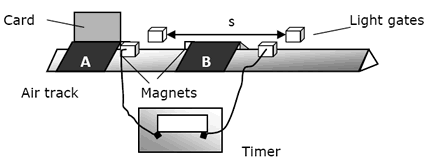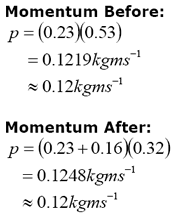Question
- Leaving Cert. Physics 2011: Section A Q.1
- Back to the question >
Answer
Draw a labelled diagram of the apparatus used in the experiment.

What adjustments did the student make to the apparatus so that body A would move at constant velocity?
Using an air-track helps to reduce the slowing effect of friction. The student could also have created a slight downward slope, so that the effect of gravity causing the velocity to increase would be offset against the friction causing the velocity to decrease.
How did the student know that body A was moving at constant velocity?
Using a linear air-track would make it easier to verify that the body was moving with constant velocity as the student could confirm that the spacing between the dots left by the ticker timer were constant.
Describe how the student measured the velocity v of the bodies after the collision.
There is a beam of light shining from one side of each light gate into the other side. When the card passes through the gate, the beam is broken. The timer is set to record the length of time this beam is broken (t). The length of the card, d, is also known. The velocity can then be measured using the formula:

Using the recorded data, show how the experiment verifies the principle of conservation of momentum.
The Principle of Conservation of Momentum states that the total momentum between two bodies before a collision will equal the total momentum after the collision provided no external forces act upon the system.


As shown here - within experimental error - the total momentum before the collision is equal to the total momentum after the collision, therefore, confirming the Principle of Conservation of Momentum.
How could the accuracy of the experiment be improved?
In reality, it is almost impossible to entirely eliminate the effects of friction; therefore, there is always an external force present in this set-up, no matter how slight.
To further improve accuracy, you could ensure that you measure velocity directly before and directly after the collision, thus ensuring that this effect is minimised.

What adjustments did the student make to the apparatus so that body A would move at constant velocity?
Using an air-track helps to reduce the slowing effect of friction. The student could also have created a slight downward slope, so that the effect of gravity causing the velocity to increase would be offset against the friction causing the velocity to decrease.
How did the student know that body A was moving at constant velocity?
Using a linear air-track would make it easier to verify that the body was moving with constant velocity as the student could confirm that the spacing between the dots left by the ticker timer were constant.
Describe how the student measured the velocity v of the bodies after the collision.
There is a beam of light shining from one side of each light gate into the other side. When the card passes through the gate, the beam is broken. The timer is set to record the length of time this beam is broken (t). The length of the card, d, is also known. The velocity can then be measured using the formula:

Using the recorded data, show how the experiment verifies the principle of conservation of momentum.
The Principle of Conservation of Momentum states that the total momentum between two bodies before a collision will equal the total momentum after the collision provided no external forces act upon the system.


As shown here - within experimental error - the total momentum before the collision is equal to the total momentum after the collision, therefore, confirming the Principle of Conservation of Momentum.
How could the accuracy of the experiment be improved?
In reality, it is almost impossible to entirely eliminate the effects of friction; therefore, there is always an external force present in this set-up, no matter how slight.
To further improve accuracy, you could ensure that you measure velocity directly before and directly after the collision, thus ensuring that this effect is minimised.
